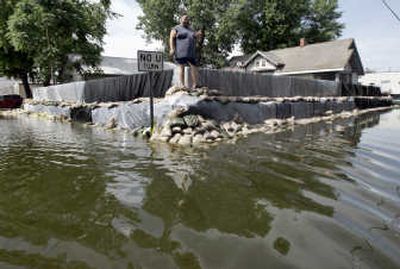After the flood, what to do with all the sandbags?

CLARKSVILLE, Mo. – When Mayor Jo Anne Smiley looks down Washington Street at the soggy fortress of sandbags protecting her town, she knows it’s a view she will have to get used to.
The sandbags are ugly. They clutter the streets in the picturesque town of 500, blocking access to the century-old brick storefronts housing antiques stores and arts shops. Some of the bags – soaked with God-knows-what from the flooded Mississippi River – stink.
But they’re staying put.
“Certainly it will be the end of July before we even think about taking down the sandbags,” Smiley said. “No choice. We have to be diligent through the summer. We have to leave them up until we know the river has crested for the last time.”
As the waters finally begin to recede across the Midwest, dozens of flooded-out towns must now decide what to do with the millions of sandbags that were painstakingly filled and stacked against nature.
Dry sandbags can safely be kept for future use. The Army Corps of Engineers recommends, though, that communities remove their wet sandbags and take the filthy, contaminated sand to the dump once the threat of flooding has passed.
“Those sandbags can be contaminated with a lot of bad things from the river – feces, chemicals, all kinds of bacteria,” said Corps spokesman Ron Fournier. “You don’t know what could be in the water, and that absorbs into the sandbags.”
But removing them will be a monumental task, just as filling them was. And with the long-range forecast calling for a wet summer, many communities are keeping their sandbags in place for now, or they are storing them nearby, just in case.
“We are anticipating an entire summer of yo-yoing river levels,” said Jeff McReynolds, who led the effort to fortify the levee protecting Canton, Mo., with 3 feet of sandbags. “Are we concerned? I’m very concerned. Sandbagging efforts will remain intact for the rest of the summer.”
In an era when technology can become obsolete in a matter of months, people in the Midwest generally fight floods the same way their great-grandparents did – fill a bag with sand and throw it on the pile. In fact, sandbags have been around since at least the Revolutionary War.
This year, the Army Corps of Engineers alone provided more than 13 million empty sandbags – they cost about 25 cents each – to flooded communities. Virtually all of them, and probably millions more provided by local communities, were filled.
Both the bags and the sand inside them can be taken to landfills. Most of the bags are made of polypropylene that will break down after several months. A few are made of burlap, which will decompose more slowly.
The sand from the bags should not be used in sandboxes or for other recreational purposes because of contamination from polluted river water, experts say.